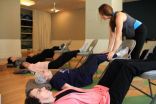The findings mean that the so-called Paleocene-Eocene thermal maximum, or PETM, can provide clues to the future of modern climate change.
The good news: Earth and most species survived.
The bad news: It took millennia to recover from the episode, when temperatures rose by 5 to 8 degrees Celsius (9 to 15 degrees Fahrenheit).
"There is a positive note in that the world persisted, it did not go down in flames, it has a way of self-correcting and righting itself," says University of Utah geochemist Gabe Bowen, lead author of a paper published today in the journal Nature Geoscience.
"However, in this event it took almost 200,000 years before things got back to normal."
Using continental drilling boreholes from the Bighorn Basin of Wyoming, "these researchers have revealed for the first time that two rapid carbon release events occurred in the beginning of the PETM about 55.5 million years ago, the warmest period for the past 65 million years on Earth," says Yusheng (Chris) Liu, program director in the National Science Foundation's (NSF) Division of Earth Sciences, which funded the research.
Bowen and colleagues report that carbonate or limestone nodules in Wyoming sediment cores show that the global warming episode 55.5 million to 55.3 million years ago involved the average annual release of a minimum of 0.9 petagrams (1.98 trillion pounds) of carbon to the atmosphere, and probably much more over shorter periods.
That's "within an order of magnitude of, and may have approached, the 9.5 petagrams (20.9 trillion pounds) per year associated with modern anthropogenic carbon emissions," the researchers write in their paper.
Since 1900, human burning of fossil fuels has emitted an average of 3 petagrams per year--even closer to the rate 55.5 million years ago.
Each past pulse of carbon emissions lasted no more than 1,500 years. Previous conflicting evidence indicated that the carbon release lasted anywhere from less than a year to tens of thousands of years.
The new research shows that atmospheric carbon levels returned to normal within a few thousand years after the first pulse, probably as carbon dissolved in the ocean.
200,000 years for conditions to normalize
After the second pulse, it took up to 200,000 years for conditions to normalize.
The research also ruled as unlikely some theorized causes of the warming episode, including an asteroid impact, slow melting of permafrost, burning of organic-rich soil or drying out of a major seaway.
Instead, the findings suggest that more likely causes included melting of seafloor methane ices known as clathrates, or volcanism that heated organic-rich rocks and released methane.
"The Paleocene-Eocene thermal maximum has stood out as a striking, but contested, example of how 21st-century-style atmospheric carbon dioxide buildup can affect climate, environments and ecosystems worldwide," says Bowen.
"This new study tightens the link. Carbon release back then looked a lot like human fossil-fuel emissions today, so we might learn a lot about the future from changes in climate, plants and animal communities 55.5 million years ago."
Bowen cautioned, however, that global climate already was much warmer than today's when the Paleocene-Eocene warming began, and there were no icecaps, "so this happened out on a different playing field than what we have today."
Paper co-author Scott Wing, a paleobiologist at the Smithsonian Institution in Washington, D.C., adds, "This study gives us the best idea yet of how quickly this vast amount of carbon was released at the beginning of the global warming event we call the Paleocene-Eocene thermal maximum.
"The answer is just a few thousands of years or less. That's important because it means the ancient event happened at a rate more like human-caused global warming than we ever realized."
Bowen and Wing conducted the study with University of Utah geologists Bianca Maibauer and Amy Steimke; Mary Kraus of the University of Colorado, Boulder; Ursula Rohl and Thomas Westerhold of the University of Bremen, Germany; Philip Gingerich of the University of Michigan; and William Clyde of the University of New Hampshire.
Effects of the Paleocene-Eocene warming
Bowen says that previous research has shown that during the Paleocene-Eocene warming period, there was "enhanced storminess in some areas and increased aridity in other places. We see continent-scale migration of animals and plants, and ranges shifting."
First, "we see only a little bit of extinction--some groups of deep-sea foraminifera, one-celled organisms, that go extinct at the start of this event. Not much else went extinct."
Then "we see the first wave of modern mammals showing up, including ancestral primates and hoofed animals," he adds. Oceans became more acidic, as they are now.
"We look through time recorded in those rocks, and this warming event stands out, and everything happens together," Bowen says.
"We can look back in Earth's history and say this is how this world works, and it's totally consistent with the expectation that carbon dioxide change today will be associated with these other sorts of change."
The Paleocene-Eocene thermal maximum also points to the possibility of runaway climate change enhanced by feedbacks.
"The fact we have two releases may suggest that the second one was driven by the first," perhaps, for example, if the first warming raised ocean temperatures enough to melt massive amounts of frozen methane, Bowen says.
Drilling into Earth's past
The study is part of a major drilling project aimed at understanding the 56-million-year-old warming episode.
The researchers drilled long, core-shaped, sediment samples from two boreholes at Polecat Bench in northern Wyoming's Bighorn Basin, east of Cody and just north of Powell.
"This site has been excavated for more than 100 years by paleontologists studying fossil mammals," Bowen says.
The Paleocene-Eocene warming is recorded in the banded, tan and red rock and soil layers of the Willwood formation, in round, gray to brown-gray carbonate nodules in those rocks.
By measuring carbon isotope ratios in the nodules, the researchers found that during each 1,500-year carbon release, the ratio of carbon-13 to carbon-12 in the atmosphere declined, indicating two large releases of carbon dioxide or methane, both greenhouse gases from plant material.
The decline was three parts per thousand for the first pulse and 5.7 parts per thousand for the second.
Previous evidence from seafloor sediments elsewhere is consistent with two Paleocene-Eocene carbon pulses, which "means we don't think this is something unique to northern Wyoming," Bowen says. "We think it reflects a global signal."
What caused the prehistoric warming?
The double-barreled carbon release at the Paleocene-Eocene time boundary pretty much rules out an asteroid or comet impact because such a catastrophe would have been "too quick" to explain the 1,500-year duration of each carbon pulse, Bowen says.
Another theory: oxidation of organic matter--as permafrost thawed, as peaty soils burned, or as a seaway dried up--may have caused the Paleocene-Eocene warming. But that would have taken tens of thousands of years, far slower than what the study found. Volcanoes releasing carbon gases also would have been too slow.
Bowen says the two relatively rapid carbon releases--about 1,500 years each--are more consistent with warming oceans or an undersea landslide triggering the melting of frozen methane on the seafloor and large emissions to the atmosphere, where it became carbon dioxide within decades.
Another possibility is a massive intrusion of molten rock that heated overlying organic-rich rocks and released a lot of methane.
INFORMATION:
The research was also funded by the German Research Foundation.
-NSF-








